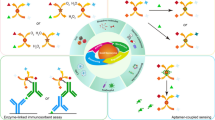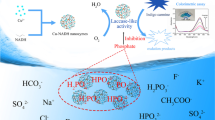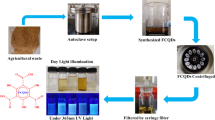Abstract
A facile strategy for detecting xanthine in serum samples by copper nanocluster (CuNCs) with high intrinsic peroxidase-like activity was reported. Firstly, a simple, mild and time-saving method for preparing CuNCs was developed, in which dithiothreitol (DTT) and bovine serum albumin (BSA) were used as reductant and stabilizer, respectively. The as-prepared CuNCs exhibited a fluorescence emission at 590 nm with a quantum yield (QY) of approximately 5.29%, the fluorescence intensity of the as-prepared CuNCs exhibited no considerable change when stored under ambient condition with the lifetime is 1.75 μs. Moreover, the as-prepared CuNCs exhibited high intrinsic peroxidase-like activity with lower K m (K m = 8.90 × 10−6 mol L−1) for H2O2, which indicated that CuNCs have a higher affinity for H2O2. Compared with natural enzyme, the as-synthesized CuNCs are more catalytic stable over a wide range of pH (4.0~13.0) and temperature (4~80 °C). Finally, an indirect method for sensing xanthine was established because xanthine oxidase can catalyse the oxidation of xanthine to produce H2O2. Xanthine could be detected as low as 3.8 × 10−7 mol L−1 with a linear range from 5.0 × 10−7 to 1.0 × 10−4 mol L−1. These results proved that the proposed method is sensitive and accurate and could be successfully applied to the determination of xanthine in the serum sample with satisfaction.










Similar content being viewed by others
References
Baranowska I, Zydroń M (2002) Quantitative structure-retention relationships of xanthines in RP HPLC systems with the new Chromolith RP-18e stationary phases. Anal Bioanal Chem 373(8):889–892
Behera TK, Sahu SC, Satpati B, Bag B, Sanjay K, Jena BK (2016) Branched platinum nanostructures on reduced graphene: an excellent transducer for nonenzymatic sensing of hydrogen peroxide and biosensing of xanthine. Electrochim Acta 206:238–245
Caussé E, Pradelles A, Dirat B, Negresalvayre A, Salvayre R, Couderc F (2007) Simultaneous determination of allantoin, hypoxanthine, xanthine, and uric acid in serum/plasma by CE. Electrophoresis 28(3):381–387
Çevik S (2016) Xanthine biosensor based on XO/AuNP/PtNP/MWCNT hybrid nanocomposite modified GCPE. Biotechnol Bioprocess Eng 21(2):314–320
Chandirasekar S, Chandrasekaran C, Muthukumarasamyvel T,Sudhandiran G, Rajendiran N (2016) Biosurfactant templated quantum sized fluorescent gold nanoclusters for in vivo bioimaging in zebrafish embryos. Colloids Surf B Biointerfaces 143:472
Chattopadhyay S, Dey SK, Maiti PK, Dolai D (2014) A novel tool for capture and detection of typhoid fever using Ag-labeled nanocomposites. JBIC Journal of Biological Inorganic Chemistry 19(8):1377–1384
Chen L, Zeng G, Zhang Y, Tang L, Huang D, Liu C, Pang Y, Luo J (2010) Trace detection of picloram using an electrochemical immunosensor based on three-dimensional gold nanoclusters. Anal Biochem 407(2):172–179
Cooper N, Khosravan R, Erdmann C, Fiene J, Lee JW (2006) Quantification of uric acid, xanthine and hypoxanthine in human serum by HPLC for pharmacodynamic studies. J Chromatogr B 837(1–2):1–10
Deng HH, Wang FF, Shi XQ, Peng HP, Liu AL, Xia XH, Chen W (2016) Water-soluble gold nanoclusters prepared by protein-ligand interaction as fluorescent probe for real-time assay of pyrophosphatase activity. Biosens Bioelectron 83:1
Ding C, Yan Y, Xiang D, Zhang C, Xian Y (2016) Magnetic Fe 3 S 4 nanoparticles with peroxidase-like activity, and their use in a photometric enzymatic glucose assay. Microchim Acta 183(2):1–7
Feng J, Ju Y, Liu J, Zhang H, Chen X (2015) Polyethyleneimine-templated copper nanoclusters via ascorbic acid reduction approach as ferric ion sensor. Anal Chim Acta 854C:153–160
Gao L, Zhuang J, Nie L, Zhang J, Zhang Y, Gu N, Wang T, Feng J, Yang D, Perrett S (2007) Intrinsic peroxidase-like activity of ferromagnetic nanoparticles. Nat Nanotechnol 2(9):577–583
Gu Y, Li N, Gao M, Wang Z, Xiao D, Li Y, Jia H, He H (2015) Microwave-assisted synthesis of BSA-modified silver nanoparticles as a selective fluorescent probe for detection and cellular imaging of cadmium(II). Microchim Acta 182(7):1255–1261
Hu L, Yuan Y, Zhang L, Zhao J, Majeed S, Xu G (2013) Copper nanoclusters as peroxidase mimetics and their applications to H2O2 and glucose detection. Anal Chim Acta 762(1):83–86
Hu X, Mao X, Zhang X, Huang Y (2017) One-step synthesis of orange fluorescent copper nanoclusters or sensitive and selective sensing of Al3+ ions in food samples. Sensors Actuators B 247:312–318
Jiang X, Sun C, Guo Y, Nie G, Xu L (2015) Peroxidase-like activity of apoferritin paired gold clusters for glucose detection. Biosens Bioelectron 64:165
Ke CY, Wu YT, Tseng WL (2015) Fluorescein-5-isothiocyanate-conjugated protein-directed synthesis of gold nanoclusters for fluorescent ratiometric sensing of an enzyme-substrate system. Biosens Bioelectron 69:46–53
Li D, Li B, Yang SI (2015a) A selective fluorescence turn-on sensing system for evaluation of Cu2+ polluted water based on ultra-fast formation of fluorescent copper nanoclusters. Anal Methods 7(6):2278–2282
Li R, Wang H, Zhou X, Liao X, Sun X, Li Z (2015b) D-Penicillamine and bovine serum albumin co-stabilized copper nanoclusters with remarkably enhanced fluorescence intensity and photostability for ultrasensitive detection of Ag+. New J Chem 40(1):732–739
Li GL, Ma P, Zhang YF, Liu XL, Zhang H, Xue WM, Mi Y, Luo YE, Fan HM (2016) Synthesis of Cu 2 O nanowire mesocrystals using PTCDA as a modifier and their superior peroxidase-like activity. J Mater Sci 51(8):3979–3988
Liao X, Li R, Li Z, Sun X, Wang Z, Liu J (2015a) Fast synthesis of copper nanoclusters through the use of hydrogen peroxide additive and their application for the fluorescence detection of Hg2+ in water samples. New J Chem 39(7):5240–5248
Liao X, Li R, Long X, Li Z (2015b) Ultra sensitive and wide-range pH sensor based on the BSA-capped Cu nanoclusters fabricated by fast synthesis through the use of hydrogen peroxide additive. RSC Adv 5(60):48835–48841
Liu Y, Wang C, Cai N, Long S, Yu F (2014) Negatively charged gold nanoparticles as an intrinsic peroxidase mimic and their applications in the oxidation of dopamine. J Mater Sci 49(20):7143–7150
Liu Q, Jiang Y, Zhang L, Zhou X, Lv X, Ding Y, Sun L, Chen P, Yin H (2016) The catalytic activity of Ag2S-montmorillonites as peroxidase mimetic toward colorimetric detection of H2O2. Mater Sci Eng C Mater Biol Appl 65:109–115
Lu W, Chang G, Luo Y, Fang L, Sun X (2011) Method for effective immobilization of Ag nanoparticles/graphene oxide composites on single-stranded DNA modified gold electrode for enzymeless H 2 O 2 detection. J Mater Sci 46(15):5260–5266
Luo Y, Hong M, Yang X (2015) Glutathione-stabilized Cu nanoclusters as fluorescent probes for sensing pH and vitamin B 1. Talanta 144:488–495
Mu S, Shi Q (2013) Xanthine biosensor based on the direct oxidation of xanthine at an electrogenerated oligomer film. Biosens Bioelectron 47(2):429–435
Pergolese B, Muniz-Miranda M, Bigotto A (2006) Surface-enhanced Raman scattering investigation of the adsorption of 2-mercaptobenzoxazole on smooth copper surfaces doped with silver colloidal nanoparticles. J Phys Chem B 110(18):9241–9245
Qiao F, Wang J, Ai S, Li L (2015) As a new peroxidase mimetics: the synthesis of selenium doped graphitic carbon nitride nanosheets and applications on colorimetric detection of H 2 O 2 and xanthine. Sensors & Actuators B Chemical 216:418–427 (Politics)
Rao H, Ge H, Lu Z, Liu W, Chen Z, Zhang Z, Wang X, Zou P, Wang Y, He H (2016) Copper nanoclusters as an on-off-on fluorescent probe for ascorbic acid. Microchim Acta 183(5):1651–1657
Ren X, Liu J, Ren J, Tang F, Meng X (2015) One-pot synthesis of active copper-containing carbon dots with laccase-like activities. Nano 7(46):19641–19646
Shan D, Wang YN, Zhu MJ, Xue HG, Cosnier S, Wang CY (2009) Development of a high analytical performance-xanthine biosensor based on layered double hydroxides modified-electrode and investigation of the inhibitory effect by allopurinol. Biosens Bioelectron 24(5):1171–1176
Tian R, Chen X, Xu X, Cheng Y (2014) Electrocatalytic activity of core/shell magnetic nanocomposite. Anal Biochem 463(20):45–53
Wang XX, Wu Q, Shan Z, Huang QM (2011) BSA-stabilized Au clusters as peroxidase mimetics for use in xanthine detection. Biosens Bioelectron 26(8):3614–3619
Wang C, Wang C, Xu L, Cheng H, Lin Q, Zhang C (2013) Protein-directed synthesis of pH-responsive red fluorescent copper nanoclusters and their applications in cellular imaging and catalysis. Nano 6(3):1775–1781
Wang L, Miao H, Zhong D, Yang X (2015a) Synthesis of dopamine-mediated Cu nanoclusters for sensing and fluorescent coding. Anal Methods 8(1):40–44
Wang N, Li B, Qiao F, Sun J, Fan H, Ai S (2015b) Humic acid-assisted synthesis of stable copper nanoparticles as a peroxidase mimetic and their application in glucose detection. J Mater Chem B 3(39):7718–7723
Xun Y, Luo Z, Yong Y, Yao Q, Xie J (2013) Luminescent noble metal nanoclusters as an emerging optical probe for sensor development. Chem, An Asian J 8(5):858
Yang X, Feng Y, Zhu S, Luo Y, Zhuo Y, Dou Y (2014) One-step synthesis and applications of fluorescent Cu nanoclusters stabilized by L-cysteine in aqueous solution. Anal Chim Acta 847:49–54
Yang L, Liu X, Lu Q, Na H, Liu M, Zhang Y, Yao S (2016) Catalytic and peroxidase-like activity of carbon based-AuPd bimetallic nanocomposite produced using carbon dots as the reductant. Anal Chim Acta 930:23–30
Zhang Q, Xie J, Yu Y, Lee JY (2010) Monodispersity control in the synthesis of monometallic and bimetallic quasi-spherical gold and silver nanoparticles. Nano 2(10):1962
Zhang L, Lei J, Zhang J, Ding L, Ju H (2012) Amperometric detection of hypoxanthine and xanthine by enzymatic amplification using a gold nanoparticles-carbon nanohorn hybrid as the carrier. Analyst 137(13):3126–3131
Zhang Y, Ren W, Luo HQ, Li NB (2016) Label-free cascade amplification strategy for sensitive visual detection of thrombin based on target-triggered hybridization chain reaction-mediated in situ generation of DNAzymes and Pt nanochains. Biosens Bioelectron 80(1):463–470
Zhao Q, Chen S, Huang H, Zhang L, Wang L, Liu F, Chen J, Zeng Y, Chu PK (2014) Colorimetric and ultra-sensitive fluorescence resonance energy transfer determination of H2O2 and glucose by multi-functional Au nanoclusters. Analyst 139(6):1498–1503
Acknowledgements
This work was supported by the National Natural Science Foundation of China Youth Fund (Grant No. 21601206), the National Natural Science Foundation of China (Grant No.51403237), the National Science Foundation of Jiangsu (Grant No.BK20140658), the fund of College Students Innovation Project for the R&D of Novel Drugs under Grant (No.J1030830) and the National College Students’ Innovation Entrepreneurial Training Program (No. G15019).
Author information
Authors and Affiliations
Corresponding author
Ethics declarations
Conflict of interest
The authors declare that they have no conflicts of interest.
Electronic supplementary material
ESM 1
(DOC 775 kb)
Rights and permissions
About this article
Cite this article
Yan, Z., Niu, Q., Mou, M. et al. A novel colorimetric method based on copper nanoclusters with intrinsic peroxidase-like for detecting xanthine in serum samples. J Nanopart Res 19, 235 (2017). https://doi.org/10.1007/s11051-017-3904-9
Received:
Accepted:
Published:
DOI: https://doi.org/10.1007/s11051-017-3904-9




